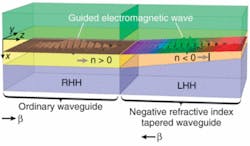METAMATERIALS: Optical guiding slows light to speed it up

The ability to route, switch, and store information in broadband telecommunications networks typically depends on electrical signals, but a new optical technique to slow down and trap light may offer a 1000% speed-up of Internet traffic.1
Researchers at the University of Surrey (Guildford, England) say they have shown theoretically that guided electromagnetic fields can be stopped while traveling inside an axially varying left-handed heterostructure (LHH), essentially creating a “trapped rainbow” storage of light. This rainbow at a standstill could open the way to applications in optical data processing and storage in numerous markets.
Photons have been slowed and captured before, but have only worked with one specific frequency at a time. Previous methods have also been quite costly says Ortwin Hess, professor of physics at the University of Surrey. Hess and his colleagues have proposed a technique using negative-refractive-index metamaterials that display the Goos Hänchen effect, in which light travels very slightly backward along an interface between two media. Using a tapered layer of glass surrounded by two layers of negative-refractive-index metamaterials, injected white light slows down within the prism-shaped taper.
The group velocity progressively becomes smaller until it reaches zero at a particular width of the taper (see figure). Where it stops, the light rays undergo two negative Goos-Hänchen shifts at the interfaces, giving the rays an hourglass shape. Because the different components of white light travel at different frequencies, individual wavelengths stop at different stages along the taper, causing the “trapped rainbow” effect. The scheme involves solid-state materials, so the effect does not require cryogenic low temperatures or atomic coherence.
After a wave packet is trapped, locally tuning the microphotonic structure and reverse adiabatic tapering of the LHH returns the light back into the right-handed heterostructure (RHH) with minimal reflection. The scheme is applicable to broadband radiation ranging from microwave to ultraviolet wavelengths.
“ ‘Slow down to travel faster’ ” might be the motto expressed by the need for ‘slow light,’ ” says Hess. Fast and massless photons are ideal information carriers in broadband networks, and a colossal number of them currently run unhindered through long-haul optical networks, capable of 10-terabit rates. Unfortunately, routing, switching, and storing of the photons still depends on converting the photonic information into electrical signals (currently limited to 40 Gbit/s rates) and back into optical signals—creating a traffic bottleneck. “Paradoxically, devices that allow a direct ‘slow down’ of light have the potential to significantly increase the speed of the Internet,” says Hess. Furthermore, finding a way to “halt” and store photons will enable the realization of all-optical memories and, ultimately, all-optical or quantum computers.
REFERENCES
1. K. Tsakmakidis et al., Nature 450, 397 (Nov. 15, 2007).
About the Author
Valerie Coffey-Rosich
Contributing Editor
Valerie Coffey-Rosich is a freelance science and technology writer and editor and a contributing editor for Laser Focus World; she previously served as an Associate Technical Editor (2000-2003) and a Senior Technical Editor (2007-2008) for Laser Focus World.
Valerie holds a BS in physics from the University of Nevada, Reno, and an MA in astronomy from Boston University. She specializes in editing and writing about optics, photonics, astronomy, and physics in academic, reference, and business-to-business publications. In addition to Laser Focus World, her work has appeared online and in print for clients such as the American Institute of Physics, American Heritage Dictionary, BioPhotonics, Encyclopedia Britannica, EuroPhotonics, the Optical Society of America, Photonics Focus, Photonics Spectra, Sky & Telescope, and many others. She is based in Palm Springs, California.
